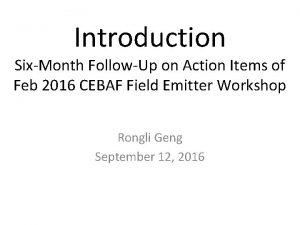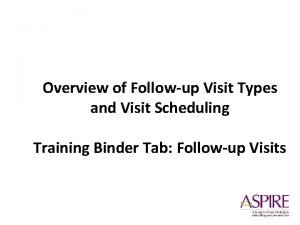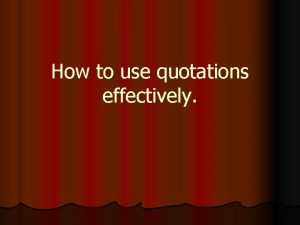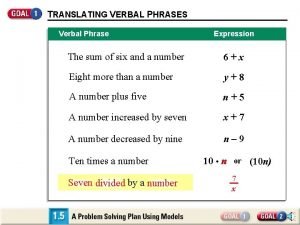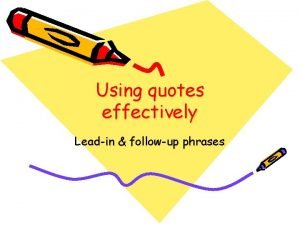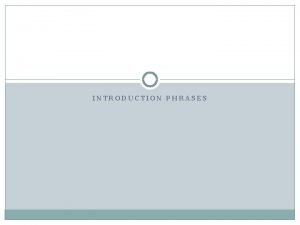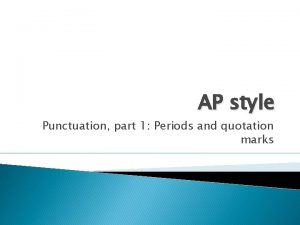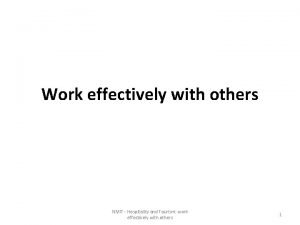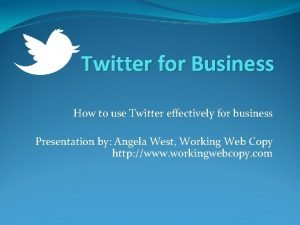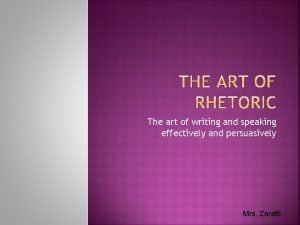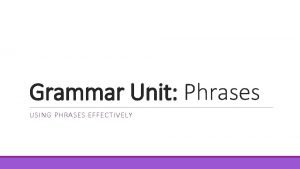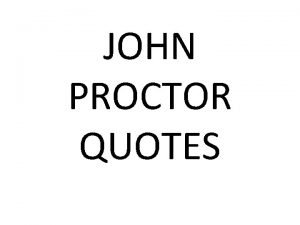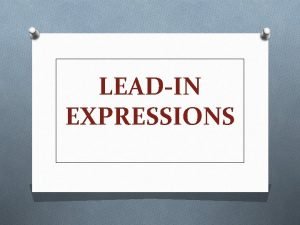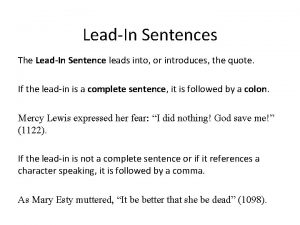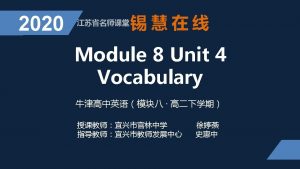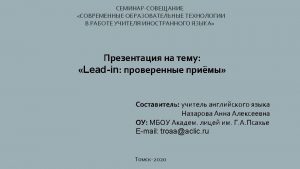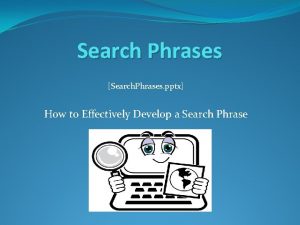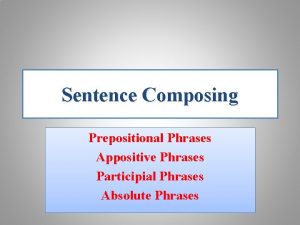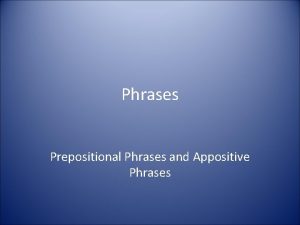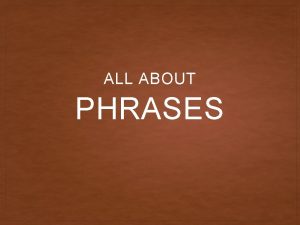Using quotes effectively Leadin followup phrases What is















- Slides: 15

Using quotes effectively Lead-in & follow-up phrases

What is a direct quotation? • Whenever you say exactly, word for word what another author, writer, or speaker has said, you are directly quoting that person, and you need to give that person credit for his or her words. • That person’s words will be shown using quotation marks in your own essay, like this: According to Professor Givhan in her class presentation, “Students should always quote someone else’s words to avoid plagiarism. ”

How do I quote? • The first thing you’ll need to do is introduce the quote in some way. • You will need to make sure you say where you got the information within your own sentence that contains the direct quote.

How to introduce a quote: • Always use a lead-in or follow-up phrase when directly quoting, so that the entire sentence is complete. • Do not just throw a quote in without explaining where it is from. • When you simply write a quote without incorporating it into your own sentence, this is called a “free-standing quote” (FSQ) • Avoid FSQs!

Example of a FSQ: Aunt Ida loved her nephew no matter what his personal life was like. “Who cared where he went when he wanted to have fun” (line 42).

How do I lead in or follow up? • Often, the easiest way to lead into or follow up a quote is simply to include the name of the author or the title of the essay (or text). • Example of author’s name: – Dr. S. Mel Badly recently stated that “stomach problems are the leading cause of bad breath. ” • Example of title of an essay: – “Bran on a regular basis intensifies the effects of prunes and cod liver oil, ” as stated in the article “The Secret to Healthy Bowels. ”

FSQ corrected: Aunt Ida loved her nephew no matter what his personal life was like. For instance, within the poem she tells the reader: “Who cared where he went when he wanted to have fun” (line 42).

Make the connection… • Next, you will need to explain how the quote relates to the point/idea you are making in that paragraph. • Do not just throw a quote in without explaining its relevance. • You are using the quote to support your opinion, so make sure your reader understands how the quote backs you up.

Making the connection with our quote… Aunt Ida loved her nephew no matter what his personal life was like. For instance, within the poem she tells the reader: “Who cared where he went when he wanted to have fun” (line 42). She seems to know that he was out with a man on Saturday night, but all that mattered to her was that he was “singing his heart out come Sunday morning” (line 43). Whatever her personal beliefs may have been, she accepted her nephew for who he was and chose to see the good in him. Aunt Ida demonstrates unconditional love, much like the love I argue characterizes “real” family.

Another example of making connections… The narrator of “An Indian Story” points out how the bond between his caregiver aunt is just as strong as if she were his biological mother. He says that he “walked into her life like. . . the baby she never had” and that “[s]he had so much love and knowledge to share” with him (Jack 53). Although Greta is not the narrator’s mother, she raises him and considers him her son; in essence, she fulfills the maternal role, which makes her his mother. The relationship between Aunt Greta and her “boy” illustrates my point that the “realness” of a family does not depend on biological connections but rather on the familial roles that are fulfilled. Aunt Greta acts as the boy’s mother; thus, for all intents and purposes, she is his mother. She is his “real” family not only because she is related to him by blood but, more importantly, because she acts as his real family.

Another example of making connections… Although many Americans look back to the 1950 s as the period in which the ideal of “family values” were modeled, those who look back with rose colored glasses often forget that this time period was also deeply troubled for many families who did not fit the “norm. ” For example, family history professor Stephanie Coontz argues that “the stability of family and community life during the 1950 s rested on pervasive discrimination against women, gays, political dissidents, non-Christians, and racial or ethnic minorities as well as on the systematic cover-up of the underside of many families” (44). So, not only were the 1950 s a time of struggle for many minority and alternative families, but the maintenance of the “ideal” Caucasian families portrayed on T. V. shows like “Leave it to Beaver” actually depended on the subversion or repression of “others, ” or those who did not fit the mold of “model” (white) suburban family.

Always… • Lead in or follow up a quote with some phrase or idea that helps transition between the direct quote and your idea/point. • Examples of lead-in and follow-up phrases: agrees concludes illustrates claims reports says admits endorses asserts argues declares supports believes suggests writes denies grants observes emphasizes claims

Never… • Forget to lead in or follow up a direct quote • Fail to explain the meaning of a quote • Neglect to connect the quote to the idea/opinion you are expressing.

A note about punctuation… • Punctuation goes inside the quotation marks. – Example: In his article about whether or not juvenile offenders should be tried as adults, Steinberg argues that “adolescence is a period of potential malleability. ” • Notice that the period goes inside the quotation marks.

Quote workshop… Now, let’s work on creating lead-in and follow-up phrases for our quotes and making connections between our quotes and our paragraph’s main points.
 Followup edge
Followup edge Followup:actionitems
Followup:actionitems Followup visit
Followup visit How to effectively use quotes
How to effectively use quotes The art of using language effectively and persuasively
The art of using language effectively and persuasively Art of using language effectively
Art of using language effectively Verbal phrases to mathematical phrases examples
Verbal phrases to mathematical phrases examples Transition phrases for quotes
Transition phrases for quotes Signal words to introduce a quote
Signal words to introduce a quote Quotation signal phrases
Quotation signal phrases Nosotros _____ lavamos las manos antes de comer.
Nosotros _____ lavamos las manos antes de comer. Combine phrases
Combine phrases Ap style quotations
Ap style quotations Work effectively in hospitality service
Work effectively in hospitality service How to effectively use twitter
How to effectively use twitter It is the art of writing and speaking
It is the art of writing and speaking

